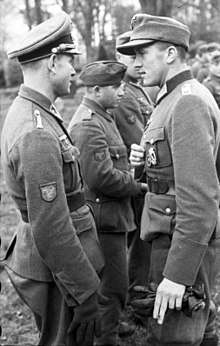Ostlegionen
Ostlegionen ("eastern legions"), Ost-Bataillone ("eastern battalions"), Osttruppen ("eastern troops"), and Osteinheiten ("eastern units") were units in the Army of Nazi Germany during World War II made up of personnel from the Soviet Union. They were a large part of the Wehrmacht foreign volunteers and conscripts.


Background
Some members of the Ostlegionen units were conscripted or coerced into serving; others volunteered. Many were former Soviet personnel, recruited from prisoner of war camps. Osttruppen were frequently stationed away from front lines and used for coastal defence or rear-area activities, such as security operations, thus freeing up regular German forces for front-line service. They belonged to two distinct types of units:
- Ost-Bataillone were composed of various nationalities, raised mostly amongst prisoners of war (POW) captured in Eastern Europe, who had been formed into battalion-sized units, which were integrated individually into German combat formations, and;
- Ostlegionen were larger foreign legion-type units raised amongst members of a specific ethnic minority or minorities, and comprising multiple battalions.
Members of Osteinheiten usually faced execution or harsh terms of imprisonment, if they were captured by Soviet forces or repatriated to the USSR by the western Allies.
Ost-Bataillone
Ost-Bataillone wore German uniforms and equipment and were integrated into larger German formations. They began as the private initiatives of individual military commanders. Most were utilized on the Eastern Front and in the Balkans.
During 1944, a number of Ost-Bataillone were stationed in northern France, in anticipation of an Allied invasion of Western Europe. Units that fought in Normandy against Allied Operation Overlord were part of the German 243rd and 709th Static Infantry Divisions, positioned in the vicinity of the Utah, Juno and Sword invasion beaches.[1] Ost-Bataillone were also present in southern France, during the Allied landings codenamed Operation Dragoon (August 1944).
Ostlegionen
| Name of unit | Size and composition |
|---|---|
| Russian Liberation Army | Known as the "Vlasov Army"; a corps-sized formation composed mostly of Soviet citizens under the command of the former Soviet general Andrey Vlasov. |
| Ukrainian Liberation Army | Various Ukrainian units, some 40,000 personnel. |
| 1st Cossack Cavalry Division | Cavalry division made up of Cossack volunteers; transferred in 1945 from the Wehrmacht to the Waffen-SS. |
| Georgian Legion | 10 battalions, consisting of ethnic Georgians. |
| Armenian Legion | Eleven battalions consisting of ethnic Armenians. |
| Azerbaijani Legion | Initially, Azerbaijanis were included into Kaukasisch-Mohammedanische Legion until 1942 when a separate legion composed of only Azerbaijanis was formed. |
| Caucasian-Mohammedan Legion | Composed of Circassians, Daghestanis, Chechens, Ingushes, and Lezghins. |
| North Caucasian Legion / Mountain-Caucasian Legion | Consisted of Abkhazians, Circassians, Kabardians, Balkars, Karachais, Chechens, Ingushes, Daghestanis, Kurds, Talyshis, and North Ossetians, separated from the Caucasian-Mohammedan Legion in accordance with the order of 19 February 1942. |
| Turkestan Legion | 8 battalions, composed of Turkmens, Uzbeks, Kazakhs and other Central Asian nationalities; they saw action as the 162nd Turkoman Division, in Yugoslavia and Italy. |
| Idel-Ural Legion | Composed of volunteers from Idel-Ural peoples including Tatars, Bashkirs, Chuvashes, Udmurts, and Mordvins. |
| Freiwilligen-Stamm-Division (Regular Volunteer Division) | Established 1944, and consists of Turkic, Azerbaijani, Georgian, Tartar, Cossack, Armenian and other Soviet volunteers, spread over five regiments. Involved in anti-partisan operations against the French Resistance. Known for the Dortan Massacre in July 1944. [2][3][4] |
References
- Ambrose, Stephen (1997). D-Day, June 6, 1944: the Battle for the Normandy Beaches. London: Simon & Schuster. p. 34. ISBN 0-7434-4974-6.
- Thomas (2000), p. 11.
- Lieb (2007), pp. 61–62, 119, 310, 338.
- Kedward (1993), p. 280.
Bibliography
- Kedward, Harry Roderick (1993). In Search of the Maquis : Rural Resistance in Southern France 1942–1944:. Clarendon Press. ISBN 978-0191591785.CS1 maint: ref=harv (link)
- Lieb, Peter (2007). Konventioneller Krieg oder NS-Weltanschauungskrieg. Kriegführung und Partisanenbekämpfung in Frankreich 1943/44 [Conventional or NS-ideological war. Warfare and anti-partisan fighting in France 1943/44] (in German). R. Oldenbourg Verlag. ISBN 978-3486579925.CS1 maint: ref=harv (link)
- Thomas, Nigel (2000). The German Army 1939–45 (5): Western Front 1943–45: Western Front, 1944–45 v. 5 (Men-at-Arms). Osprey Publishing. ISBN 978-1855327979.CS1 maint: ref=harv (link)